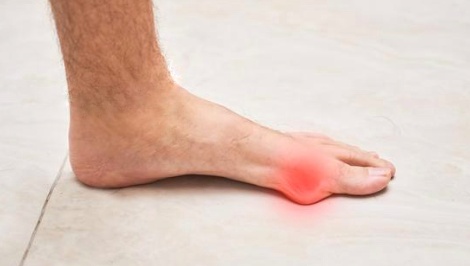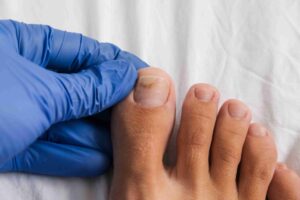The Crown and History of Gout and 5 Common Painful Foot Conditions
Are you suffering from extreme pain somewhere in your foot? Does it bother you and makes it difficult to walk?
One cause of persistent foot pain is arthritis. May is Arthritis Awareness Month and we will dig deep into this so we can be aware of this condition. Foot pain is not normal. It should not be an expected part of the aging process. There’s no need to ignore and bear it.
Here are 5 of the most common painful foot conditions we see in the clinic: Gout, Rheumatoid Arthritis, Neurovascular Corns, Compartment Syndrome, and Peripheral Neuropathy. We will take a look at them one by one as to what are the causes, symptoms and prevention of each condition.
5 most painful foot conditions
Gout
Gout derives from the latin term ‘Gutta’ from a liquid drop cited as the notion of “the ‘dropping’ of morbid material from the blood in and around the joints”.
Historically Gout was described as ‘the disease of kings’ and is caused by a diet heavy in meat. When King Henry VIII contracted gout, it became a fashionable condition. Just as the French imitated royalty at Versailles, the English nobility considered gout as a status symbol.
In today’s society gout is less of a status symbol but more of a common kind of arthritis. It is characterized by recurrent attacks of excruciating joint pain, swelling, and redness. An attack of gout typically occurs suddenly,often overnight, in contrast to other types of arthritis that develop slowly. Most frequently the joint at the big toe is mostly affected but gout can also affect the other joints in the feet, ankles, knees, elbows, wrists, and fingers.
A common waste product called uric acid accumulates in your bloodstream and creates urate crystals in a joint, causing gout. Your body makes uric acid when it breaks down purines, a substance found in your body and in some foods. Uric acid builds up in your blood if your body produces too much of it or if your kidneys are unable to remove enough of it. Hyperuricaemia is the term for this.
You’re more likely to have a gout attack if:
- you are male
- have a family history of gout
- drink too much alcohol (particularly beer)
- have elevated levels of uric acid in the blood
- are overweight or obese, use diuretics
- have type 2 diabetes, high blood pressure or high cholesterol, or kidney disease
- crash diet or fast.
Symptoms of a gout attack include intense joint pain, joint swelling, skin over the joint may look red and shiny, affected joint may be hot to touch, tophi (lumps of crystals that form under the skin) may occur in people who have repeated attacks.
Rheumatoid Arthritis
This autoimmune and inflammatory disease worsens over time. Extreme fatigue can be a hallmark feature. Early detection of this degenerative disease will provide the best outcomes. In rheumatoid arthritis, the tissue lining your joints on both sides of your body is attacked by your immune system. You can experience discomfort and swelling in your toes, knees, ankles, feet, and wrists.
Uncontrolled inflammation damages cartilage, which normally acts as a “shock absorber” in your joints. Your bone itself erodes eventually. This can result in your joint fusing together (an effort of your body to protect itself from constant irritation/friction).
While osteoarthritis of the foot or ankle most often affects one joint, RA usually occurs in both feet, typically in the same joint on each foot. Signs and symptoms of rheumatoid arthritis that you may experience in your feet can vary from soreness, warmth and swelling (a flare) of one or more foot joints that last a few days or longer, through to joint erosions, with joint instability, pain and associated changing foot shape.
Many people with rheumatoid arthritis experience extreme weakness, and experience ongoing feelings likened to a low-grade fever. RA symptoms may come and go.
Neurovascular Corns
These are very painful corns that are infiltrated by blood vessels and nerves. They typically present as normal hard corns do, however there are subtle features that differentiates these lesions from regular corns. Neurovascular corns are the least common form of corns but are extremely painful.
The exact cause of these particular lesions is unknown. It is theorised that pressure plays an important role in the development of the lesions. It is also theorised that smoking plays an important role in the development of these lesions.
Treatment needs to eliminate the corn this can be achieve in most cases with offloading and lifestyle modification such as smoking cessation as well as orthotic offloading.
Compartment Syndrome
Compartment syndrome occurs when pressure rises in and around muscles. The pressure is painful and can be dangerous. Compartment syndrome can limit the flow of blood, oxygen and nutrients to muscles and nerves. It can cause serious damage and possible death.
Compartment syndrome occurs most often in the lower leg. But it can also impact other parts of the leg, as well as the feet, arms, hands, abdomen (belly) and buttocks.
A serious injury or too much physical exertion can cause swelling or bleeding in a compartment. The fascia won’t expand to make room, so the swelling or bleeding puts pressure on the nerves and muscles. If the pressure gets too high, the tissues can’t get enough blood, which contains oxygen and nutrients. The tissues can die, leading to permanent damage to the area.
Peripheral Neuropathy
Peripheral neuropathy is an umbrella term for nerve diseases that affect a specific subdivision of your nervous system. It may be brought on by a variety of different illnesses, which implies a variety of symptoms may also be present. Peripheral neuropathy can also affect different body parts, depending on how and why it happens. It develops when nerves in the body’s extremities, such as the hands, feet and arms, are damaged. The symptoms depend on which nerves are affected.
Any pain in the foot is bothersome and should be a concern, talk to a podiatrist to have an exact diagnosis of your condition.
Are you suffering from any of these painful foot conditions? At The Chelsea Clinic, we can help. One of our podiatrist can assist and then recommend what treatments are best to get you back on track.  Podiatrist South Kensington
Podiatrist South Kensington
Schedule an appointment here or you may call us at +44 (0) 207 101 4000. 
We hope you have a feetastic day! 

-The Chelsea Clinic and Team
Learn more about Fungal Nails


 Podiatrist South Kensington
Podiatrist South Kensington




